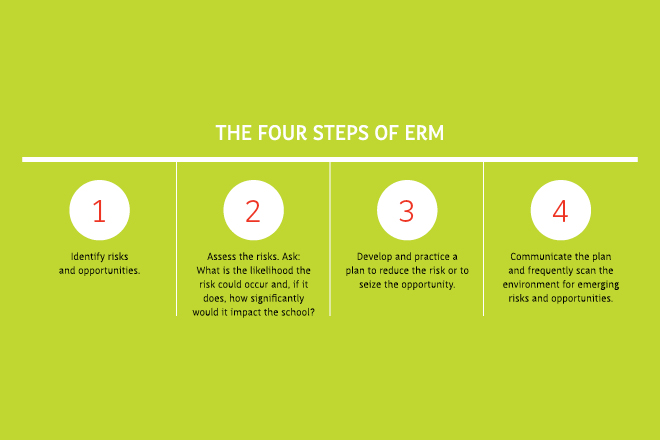Article by Janice M. Abraham, United Educators
An increasing number of independent schools are borrowing a page from colleges and corporations, using enterprise risk management (ERM) to help identify risks and take advantage of opportunities. A robust enterprise/strategic risk management program for a school starts with asking two questions:
- What keeps us up at night?
- What gets us up in the morning?
As a part of any school’s ERM strategy, opening the door to potential risks with cherished traditions is an important but often overlooked step. These are a part of every school’s culture and legacy; someone or something that has been known (often loved) and accepted for so long that no one dares question them or their behavior. They might include the special ritual for all graduating seniors; the beloved teacher who has taught and coached for decades; the class trip abroad that generations of students have participated in. Far too often, only after the tragic incident occurs or comes to light — sexual assault or molestation, excessive drinking, and on and on — does the community ask, “What were they thinking?” or “Why did we let this go on for so long?”
Team Exercises
To identify your school’s cherished traditions, form small groups — the board, faculty and administrators — to list the traditions and people that set the school apart from its peers. This exercise is gratifying, as it both reinforces strengths and differences and can highlight areas of vulnerability.
Dig deep. Cherished traditions can impact the entire school or be isolated within a single group. The band may have traditions involving welcoming new members. Ninth-graders may have an end-of-the year clean-up that involves working in teams with materials left over from science lab experiments. As harmless as they may seem at the time, such traditions could present risks that will later prompt families to ask, “How could this have been allowed to go on year after year?”
Identifying risks and opportunities is critical, but if the process begins and ends there, the school sets itself up for circumstances that can lead to injury or — worse — increased liability in the event something occurs. Using the four-step ERM framework, your next steps are to assess or evaluate those risks and then develop a plan to reduce or manage them. Asking “What are we trying to achieve by this tradition?” or “What is the value of the event?” can lead to an exploration of these questions:
- Are there other ways to achieve these values with less chance of mishap?
- Can we achieve them in ways that are safer and more in line with the expectations of families and the community?
This exercise can help your school focus on the ends and not the means, and craft a better way to build community.
School leaders are surprised to learn that issues continue to surface as the community becomes more comfortable with questioning the “We’ve always done it this way” mindset.
The final step is to communicate early and often with the broader community. Alumni, parents and neighbors as well as students, faculty, staff and the board may feel invested in traditions that they feel are under attack. Explain the shared values you identified, your emphasis on safety, and the thorough process undertaken by the school to balance the two. Being open to feedback and modifications throughout the process will at once create buy-in from the community, support long-term changes and still reflect the culture of the school.
School leaders are surprised to learn that issues continue to surface as the community becomes more comfortable with questioning the “We’ve always done it this way” mindset. Who knew the choir had a secret rite of passage for new students? Or that students, with support from alumni and some teachers, always gathered for Halloween festivities that have grown larger and less manageable amid the rise of social media? Asking the questions, assessing the risks, and identifying safer alternatives can and should be part of every school’s ERM program.
Janice M. Abraham is president and CEO of United Educators, which provides liability insurance and risk management services to nearly 1,300 schools, colleges and universities.
Download a PDF of the article.



